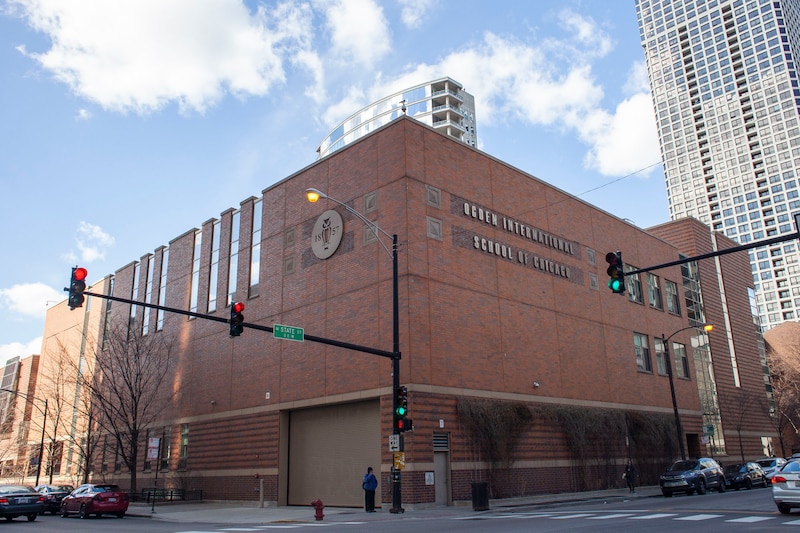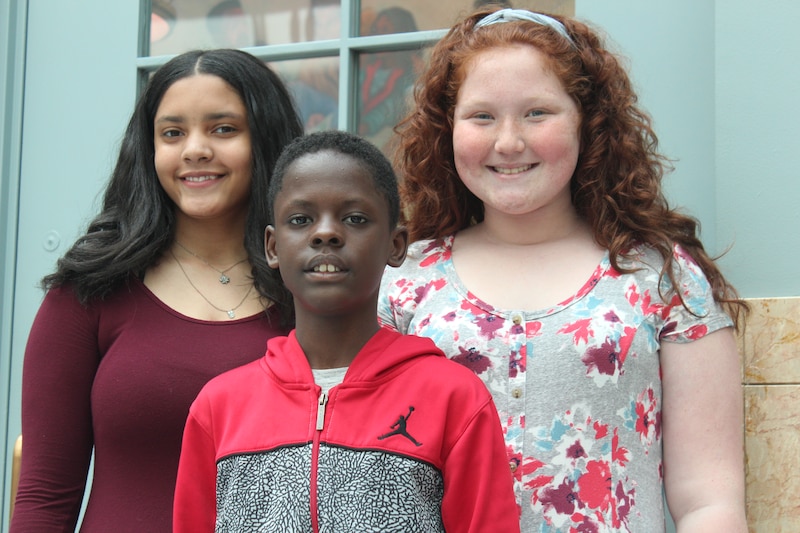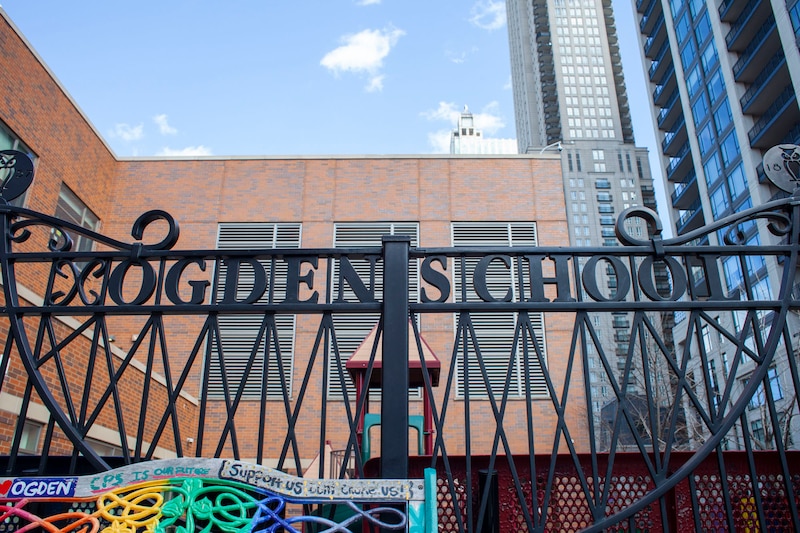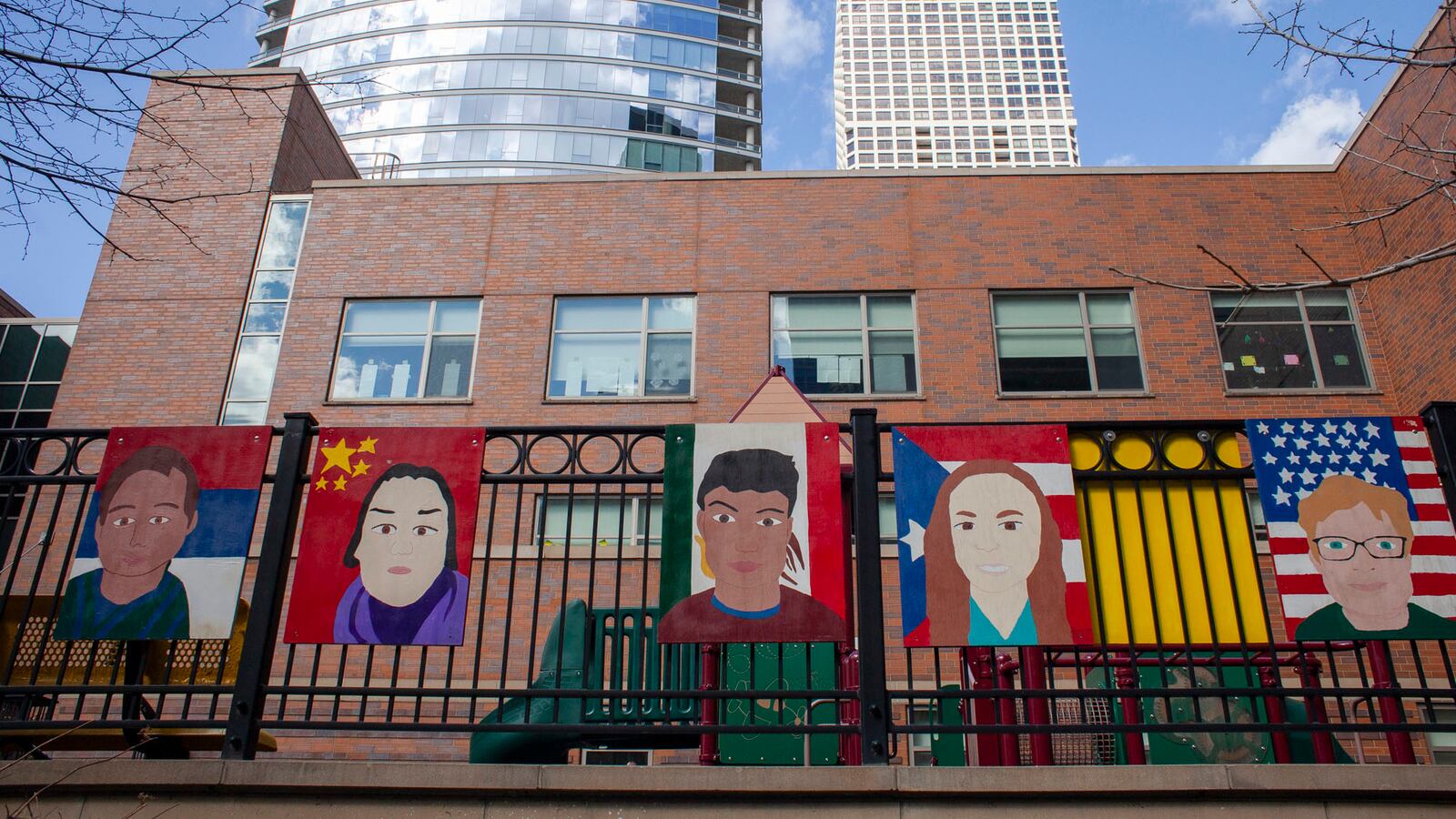As the adults around her worried about what and how they would teach, Kiara Caref had a simple concern: Would she connect with the new kids?
At Ogden International School, which last fall merged with nearby elementary school Jenner Academy for the Arts, Kiara’s friends were mostly white and middle-class like her. Jenner students were mostly black and from low-income families.
But the seventh-grader found herself building new bonds this school year. “I’m open to any type of friend,” she said. “I’m not going to grow up only being friends with people who grew up like me.”
Seventh-grader Ka’Mayra Boyd had different concerns. She was worried that the sense of community she had enjoyed at Jenner would not survive the merger.
A year later, she says she missed Jenner’s Black History Month celebration, which did not take place at the merged school. “But it’s getting better,” she said about the new school, especially social science classes that have taught her more about civil rights, local community issues and qualitative research methods.
Related: Help wanted: Ogden school looking for sixth principal in six years
Kiara and Ka’Mayra were two of 1,340 students on Chicago’s Near North Side who lived through an unusual and high-stakes initiative this year: a community-driven effort to meld two schools — racially, economically, and culturally distinct — into one.
A successful merger would offer a new model for how communities can help Chicago tackle its thorniest education challenges, including declining school enrollment and deep racial and socioeconomic segregation.
After stumbles and strides, Ogden students and teachers said that they felt like the merger was headed in the right direction and described moments where the school community had banded together to solve problems that had surfaced throughout the year. Then, on the last day of school this week, came shocking news: Acting Principal Rebecca Bancroft would be leaving the school at the end of the month.
Bancroft’s departure means that Ogden is heading into summer break with just as much uncertainty as it started the year — a daunting reality for the students, teachers, and families who have spent the year on a roller coaster ride, and for the city that could learn from their efforts.
“Ending the year in this way is a blow,” said Jezail Jackson, a first-grade teacher who also sits on the council that helps govern the school. “It feels like two steps forward and one step back for the school community.”
A “community-driven merger”

The merger talks began in 2015. Ogden, with an international focus and a diverse but largely affluent student population, was bursting at the seams. Jenner, 98 percent black and predominantly low-income, wanted to stanch an enrollment decline that nearly got it closed in 2013.
Those dynamics emerged in part from the schools’ adjacent but very different attendance zones. Ogden’s zone spanned much of the Near North Side and included a diverse swath of mostly affluent families. Jenner’s much smaller zone was confined to the area around the former Cabrini-Green projects, where many low-income black families continued to live in row homes. However, the demolition of the Cabrini high-rises — which was spurred in part by the tragic shooting of one Jenner student, Dantrell Davis, and the brutal rape of another known as “Girl X” — meant that there were far fewer children in the zone to enroll at Jenner.
Related: How it feels to be Javion — 16 and struggling to read in Chicago Public Schools
The complicated geography created a unique opportunity that parents, community leaders, teachers, and administrators seized upon as they hatched a plan to bring their schools together. They would use all three buildings — the two that Ogden already used, and Jenner’s — to serve both sets of students, relieving crowding pressure at Ogden and connecting Jenner students with the resources of a larger school. They formed a Jenner-Ogden Steering Committee and hired a consultant to help craft a merger proposal.
That proposal reflected something new for Chicago, which had closed or merged more than 170 schools, often abruptly and despite fierce community opposition, over the previous 20 years, in efforts to manage declining enrollment and chronic underperformance. Instead of having a bureaucratic solution imposed on them, the Ogden and Jenner communities remained in the driver’s seat — and got to spend several years working through potential challenges.
Related: Eve Ewing explains why some communities just can’t get over school closings
“This was more of a community-driven merger than [Chicago Public Schools] saying we’re closing this school and moving it into that school,” said first-grade teacher Deborah Sheriff, who has been through three campus mergers during her career in the district. “And this is the first merger that CPS has really been involved in two or three years before the merger happened.”
The process wasn’t easy, and opposition to the merger sprouted in both school communities.
Some Ogden parents complained that the Jenner campus was unsafe, too close to crime havens and Cabrini Green, according to meeting transcripts. Other Ogden parents worried that their school’s strong academic record and reputation would suffer if Jenner’s lower-scoring students were enrolled. An online petition against the merger garnered about 200 signatures — not a huge number, but a significant one.
Related: The tension between Chicago enrollment declines and new schools
Meanwhile, some Jenner families feared that their community would lose its identity and agency in a merged school. Some worried that Ogden was simply trying to grab their school’s building, without regard to the needs of Jenner students.
But others at Jenner were eager to escape the perpetual fear of closure and sought access to Ogden’s resources and curriculum. At Ogden, some families pushed back against resistance to the plan, accusing parents who raised concerns of harboring racist attitudes about Jenner students.
Ultimately, in February 2018, the city’s school board signed off on a merger plan. Students in both zones would go to one building together until fourth grade, then another for middle school. And students in both zones would be able to go on to Ogden’s well regarded high school.
The result: The school that opened in September is among the 10 percent of Chicago public schools with no racial majority. In a city where the majority of schools are racially segregated, 37% of Ogden students are black, 30% white, 16% Asian, and 15% Latino. And its families span the economic spectrum, from affluent Gold Coast families to public housing residents.
Related: Chicago schools equity chief promises new decision-making tool this summer
Students say the merger brought together young people who were relatively close geographically but rarely had opportunities to connect face-to-face and see through stereotypes.

When 12-year-old area resident Jacari Brown arrived at his new school in September, he found “nice new teachers, wonderful kids,” he said. “I even made some new friends right off the bat,” he said. And the classes? “Compared to last year, I’m not even going to lie — they are way better.”
The first day of school capped years of deliberate efforts to bring the two communities together.
To get students comfortable with the change, parents and students attended each other’s school open houses and report card pickups the previous year. The communities shared events, planned joint field trips, and set up pen pals for families to get to know one another. Parents formed a diversity committee, and attended workshops to address their own biases.
Teachers at the two schools also worked together. Anticipating a wide range in students’ skills, teachers learned how to flexibly group students, and to lean on each other for advice and support.
Ogden had already been using the International Baccalaureate program, a rigorous curriculum that is popular with families and increasingly common across Chicago. Observing that the IB program’s inquiry-based approach seemed well-suited for the merged school because it pushes students to think about themselves in global contexts and become more culturally aware, Jenner teachers learned how to teach the approach as well.
And the district pitched in, dedicating $1.8 million for a social worker, youth advocates, parent support, diversity training, and more. That support helped Ogden teachers to get training about how to work with children who have experienced trauma and how to manage different kinds of student behavior.
The merged school drew families and educators eager to be part of a uniquely diverse school community.
Ngozi Okorafor chose the school so that her son would be surrounded by students from different backgrounds. On her son’s first day of kindergarten, the Nigerian-American lawyer was pleased to see that he had Indian, Chinese, Nigerian, African-American, Latino, and white classmates.
“They will appreciate diversity if it is celebrated,” she said.
And teacher Maria Arellano, a native of Honduras, left Namaste Charter School to be part of a movement to foster racial and economic integration.
Her third-grade class includes students reading at the kindergarten level and others reading like sixth-graders. She said the training that she and her colleagues had received had paid dividends.
One of her students with would lash out and occasionally run out of the classroom on the spur of the moment. But through daily check-ins with him, Arellano learned he was dealing with the loss of a family member to gun violence.
She built a relationship with his mother. One day after he walked out on the classroom, Arellano said she called the mother, who told her simply, “’Put me on speaker.’” And then Mom said sweetly, “‘Honey, you need to listen to your teacher.’” The boy returned to class.
“After three months in the classroom he stopped yelling, hitting, and leaving the classroom,” Arellano said. “He’s a joy. People love him. I just saw him transform, and I think it’s not just a coincidence. … I think it’s the work we did to learn who our kids are.”
A ‘fractured’ community
But a series of challenges and missteps would undermine that work. The problems began when Jenner Principal Robert Croston, who had helped engineer the merger, died of illness at age 34 in March 2018, just after the plan was approved. That fall, shortly after the school year began, the district suspended Ogden Principal Michael Beyer for allegedly falsifying attendance records.
Related: Merged Chicago school searches for elusive balance in its ‘fractured’ community
In December, the school’s acting principal, Rebecca Bancroft, said in her monthly leadership report that Ogden was a “fractured” community. It didn’t help that the Jenner name had been dropped from the merged school, and with every turn, concerns surfaced that Jenner’s identity was being sidelined.
While the planning committee had worked to treat the two schools’ concerns equally, sheer numbers gave Ogden more influence. That school had four times as many students as Jenner in elementary school, and many more teachers as well.
That meant that the majority of teachers in the merged school were from Ogden. Most of them were white, in contrast with Jenner’s mostly black staff. And one popular black teacher at Jenner, Tara Stamps, whose family has a long tradition of activism and organizing in Cabrini Green, had not made the move. She had applied to be an assistant principal but didn’t get the job, distressing Jenner families familiar with her leadership.
Ogden voices were front and center on the new school’s Local School Council, too. The one representative from Jenner, Kizzy McCray, quickly began having doubts about participating in the leadership group. Accustomed to Jenner meetings where attendees would more freely talk and seek solutions, she said she wasn’t used to the tightly run Ogden LSC meetings with strict time limits on speakers, where she said members could have been more responsive to parent concerns.
“I got tired and overwhelmed,” said McCray, who is Ka’Mayra Boyd’s mother. She stopped attending meetings — leaving the former Jenner community without an official voice until she was voted off the council for excessive absences and the council chose a different Jenner parent to take her place.
Related: Local School Councils are a big deal. But getting new members trained is proving difficult.
Inside the school, despite the training on classroom management and social-emotional learning that teachers had received, a disturbing dynamic was emerging. Black students were being disciplined far more often than their classmates — something that research shows is a serious and pervasive problem across the country.
In the first semester after the merger, the school issued 41 suspensions, with nearly half taking the form of harsher out-of-school exclusions. Thirty-five of those suspensions were for black students, meaning that black students were being suspended at more than twice the rate expected given their share of the student population.
City data does not show whether students who were suspended came from Ogden originally, or from Jenner. But the year before the merger, Ogden had suspended just seven students all year long. (Four of them were black.)
Parent complaints fell along racial lines, according to Sheriff, the first-grade teacher who came from Jenner.
She said she fielded a call near the start of school from a parent who said, “My son is in a class with all Jenner kids, and that is not right.” There were only three students from Jenner in the class, she said — but several others were also black. More recently, she said she’s also gotten calls from parents saying their children were being bullied by “Jenner kids.”
“There’s a bias,” Sheriff said. “There’s plenty of kids who are in the school who are black who are not from Jenner.”
The divide fell into sharp relief — at least for the former Jenner students and their families — in February.
That’s when Jenner had always organized an extravagant Black History Month assembly featuring student performances of songs, African dance, and plays about black historical figures. Another highlight was a black history fair with student presentations about African-American leaders, inventors, and famous former residents from the Cabrini Green public housing projects.
This year, the fair didn’t happen, leaving students such as Boyd feeling left out. “It was more important for me to know about successful Cabrini Green people I didn’t know about,” she said.
McCray said the loss of Jenner traditions grew to feel overwhelming. “It feels like Jenner was taken over rather than actually merged,” she said.
‘Something that was lost in this process’

City education officials said they hope McCray’s sentiment can be avoided in future school mergers.
“To me it matters more that you’re telling me that a parent felt like it was a closure or a takeover,” said LaTanya McDade, the school district’s chief academic officer. “And if they felt that way, then that means there was something that was lost in this process that we have to recapture.”
Already, efforts are underway to change the tenor within the school. Late Principal Robert Croston’s widow joined the staff as a middle school counselor in March. Sheena Croston had been a fixture as a volunteer in the Jenner community and has lent a sense of continuity to the campus.
Her charge is to help students deal with emotional challenges, and coach teachers to respond compassionately, rather than just punitively, when students misbehave. But she said she also sees her role as “a pillar of strength” at the Jenner campus who can tap into her own loss to connect with students going through hard time.
“I have a smile on my face and I’m here to hold your hand, to talk to you, to support you, to be a part of every thing that everybody is feeling and doing to make this merger successful,” she said.
The district is working to improve relations at Ogden in other ways. McDade said a forthcoming parent engagement plan will ensure that former Jenner parents — who have felt excluded — have ample opportunities to volunteer and to participate in school events.
Getting it right will be important for the city. Chicago has more than 200 schools with enrollment so low that the district has begun giving out “equity grants” to help boost programs that attract families. But the district is predicted to keep shrinking, which means fewer families to draw from and tough decisions ahead. New Mayor Lori Lightfoot has said she wants to pursue alternatives to closure — something that a state law says districts must try before deciding to shutter a school.
Related: Chicago is throwing its smallest high schools a lifeline. But is it enough?
That means more mergers are likely coming to communities across Chicago, although the timeline and frequency are not yet clear. Lightfoot has said, though, that if schools do have to close or merge, the decision to do so should be community-driven, as happened at Ogden.
For now, any lessons emerging from Ogden’s first year are tempered by Bancroft’s abrupt resignation, announced Thursday in a letter to families. The city declined to offer details about her move and she did not respond to requests for comment.
With Bancroft’s resignation effective June 30, the Local School Council must scramble to choose someone else to steer the merged school into its second year. Whoever takes over the job of managing Ogden’s three campuses will face a long to-do list.
Bancroft’s last leadership report, delivered at a school council meeting in early June, outlines plans that her successor will have to oversee, including a series of student leadership retreats this summer and plan to train teachers in the coming year in IB teaching techniques, restorative justice, and other strategies for teaching students with wide-ranging needs and skills. The school also has 18 vacancies to fill this summer, including several positions added to support the merger such as an instructional coach, business manager, and a family and community communications liaison.
District officials say they are on standby to help.
“It is very important to the district and me that Ogden’s next principal continues the progress your community has made over the past two years,” McDade wrote in a letter to Ogden families. “The district will collaborate with your elected Local School Council over the summer to identify an acting principal who reflects your values and priorities, and is ready to support the continued growth of your school community when class begins in the fall.”
Also standing by: the school’s students, who came together this year in remarkable ways, and won accolades from the city for doing so.
This month, Chicago honored the Ogden-Jenner Student Voice Committee for its work promoting a positive campus culture. The committee designed and built a room where students feeling stress — about the merger or anything else — can get a break and some support.
Eighth-grader Dajae Allen recently told a crowd gathered at the Harold Washington Library for a civic honors ceremony that, at the beginning of the year, there was “an unsaid wall between the two school communities.”
But bit by bit, she said, students took it upon themselves to break down that barrier.
“We were experts on what it means to be students at our school,” Allen said, “so we needed to lead the way to advance the health of our new school community.”
Those efforts, and those of her colleagues, also leave Jackson, the first-grade teacher, optimistic about Ogden’s future.
“I know that we are all very very hard workers, and our hearts are in it,” Jackson said. “We have to work harder to ensure this success. These obstacles that keep coming, they cannot be the end all be all for us. They just can’t be, because we all just deserve more.”

